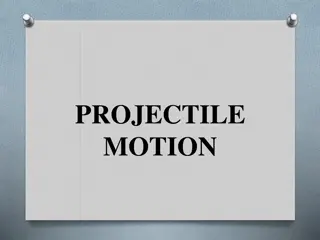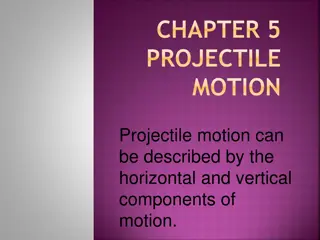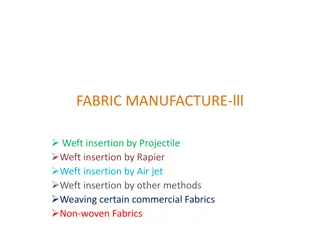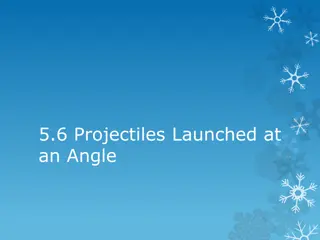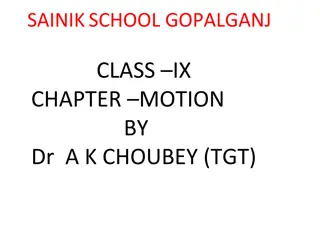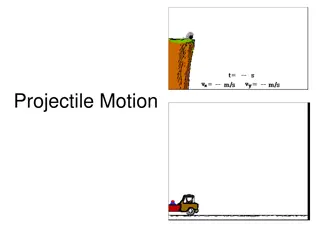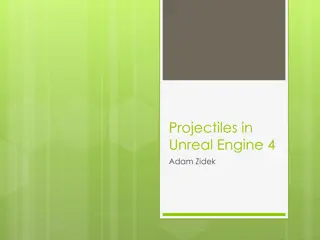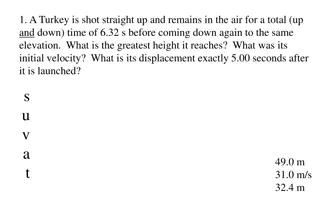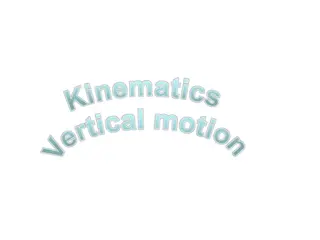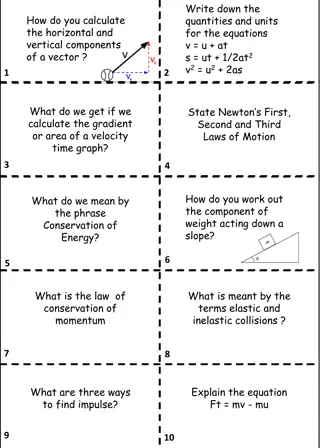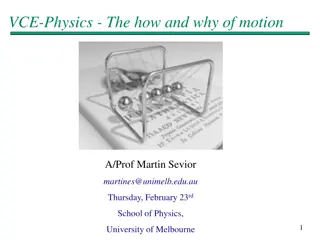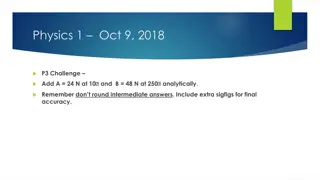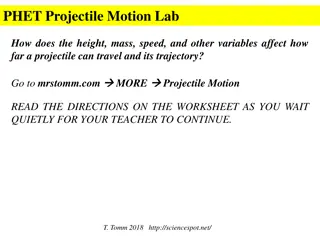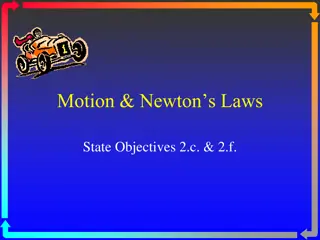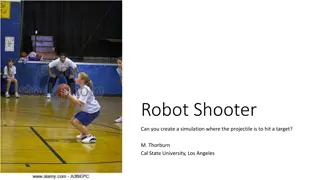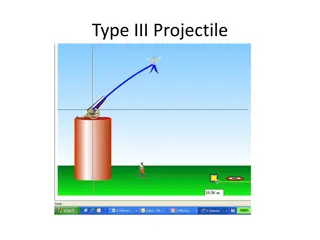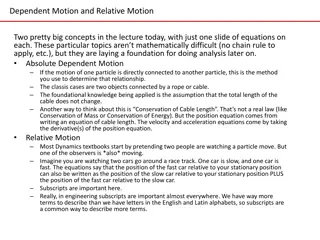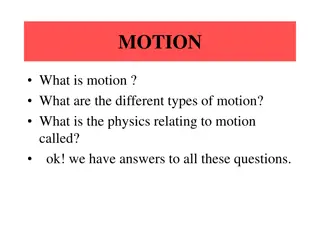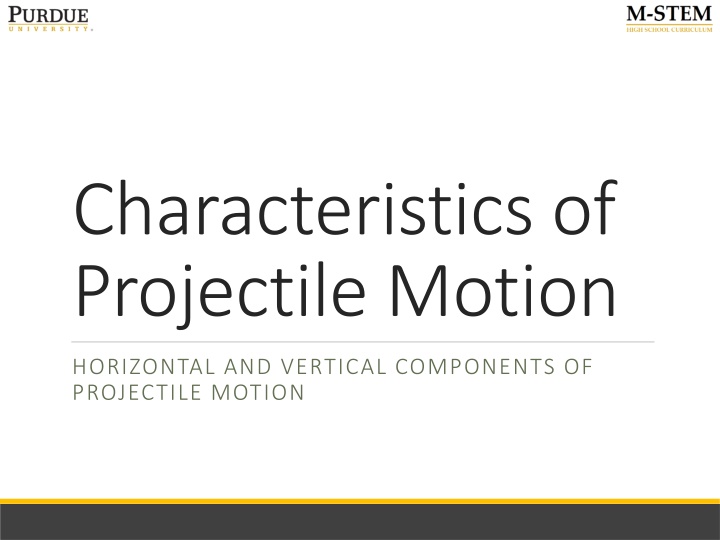
Projectile Motion: Components, Characteristics, and Sample Problems
Explore the characteristics of projectile motion involving horizontal and vertical components, from horizontally launched projectiles to non-horizontally launched ones. Learn about velocity components, resolving initial velocity, and solving sample problems to understand projectile motion better.
Download Presentation

Please find below an Image/Link to download the presentation.
The content on the website is provided AS IS for your information and personal use only. It may not be sold, licensed, or shared on other websites without obtaining consent from the author. If you encounter any issues during the download, it is possible that the publisher has removed the file from their server.
You are allowed to download the files provided on this website for personal or commercial use, subject to the condition that they are used lawfully. All files are the property of their respective owners.
The content on the website is provided AS IS for your information and personal use only. It may not be sold, licensed, or shared on other websites without obtaining consent from the author.
E N D
Presentation Transcript
Characteristics of Projectile Motion HORIZONTAL AND VERTICAL COMPONENTS OF PROJECTILE MOTION
Horizontally Launched Projectiles In the absence of gravity, a cannonball would continue its horizontal motion at a constant velocity in accordance to Newton s law of Inertia A cannon ball dropped from a cliff in the presence of gravity, would accelerate downward at a rate of 9.8 m/s2 A cannon ball fired horizontally in the presence of gravity would maintain horizontal motion while falling at a rate of 9.8 m/s2
Components of Velocity ??=? Horizontal Velocity ? Vertical Velocity ??= ? ? Horizontal velocity is constant and independent of vertical motion Vertical acceleration caused by gravitation force acting on cannon ball
Non-horizontally Launched Projectile In the presence of gravity, non-horizontally launched projectiles travel with a parabolic trajectory (curved shaped arch) Gravity still works against the vertical motion without affecting the horizontal motion
Sample Problem #1 What are the horizontal and vertical components of velocity for a cannon ball with an initial velocity of 75.7 m/s and fired at a 15o angle? The initial velocity must first be resolved into its horizontal and vertical components Initial Horizontal Velocity = 73.1m/s SOH-CAH-TOA ??= ?cos? = 75.7 ? ? cos15 = 73.1 ? ? Initial Vertical Velocity = 19.6m/s SOH-CAH-TOA ??= ?sin? = 75.7 ? ? sin15 = 19.6 ? ?
Components of Velocity cont., ? ? ??= 9.8 ? ? ??= 0 ??= 19.6 ? ? ? ? ??= 73.1 ? ? ??= 73.1 ??= 73.1 ? ? ??= 73.1 ? ? ??= 73.1 ??= 9.8 ? ? ? ? ??= 73.1 ? ? ??= 19.6 ? ? ??= 73.1 ? ? ??= 29.4 ? ? ??= 73.1 ? ? ??= 39.2 ? ? Notice that horizontal velocity remains constant while vertical velocity changes by 9.8 m/s every second. ??= 49 ? ?
Sample Problem #2 What are the horizontal and vertical displacement for a cannon ball an initial velocity of 50 m/s and fired at a 60o angle? The initial velocity must first be resolved into its horizontal and vertical components ??= 50 ? ? cos60 = 25 ? ? ??= 50 ? ? sin60 = 43.3 ? ? Horizontal Displacement is equal to the horizontal velocity time the time of flight ? = ?? ? How long does the cannon ball stay in the air?
Sample Problem #2 cont., For vertical displacement we must consider that cannon ball will rise at a rate of ? = ?? ? while gravity pulls it down at a rate of ? = 0.5 ? ?2 Combining these two equations results in ? = ?? ?+ 0.5 ? ?2
Sample Problem #2 cont., Horizontal Displacement ? = ?? ? 0 m 25 m 50 m 75 m 100 m 125 m 150 m 175 m 200 m 225 m Vertical Displacement ? = ?? ? + ?.? ? ?? Time 0 s 1 s 2 s 3 s 4 s 5 s 6 s 7 s 8 s 9 s 0 m 38.4 m 67 m 85.8 m 94.8 m 94 m 83.4 m 63 m 34.8 m -7.2 m

